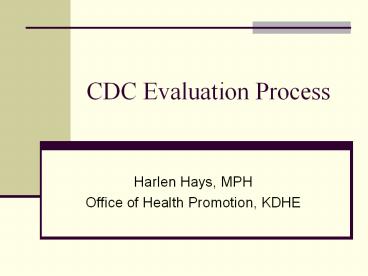CDC%20Evaluation%20Process - PowerPoint PPT Presentation
Title:
CDC%20Evaluation%20Process
Description:
CDC Evaluation Process Harlen Hays, MPH Office of Health Promotion, KDHE Help! Someone Wants Our Program to be Accountable We live in a data driven world The trick is ... – PowerPoint PPT presentation
Number of Views:115
Avg rating:3.0/5.0
Title: CDC%20Evaluation%20Process
1
CDC Evaluation Process
- Harlen Hays, MPH
- Office of Health Promotion, KDHE
2
Help! Someone Wants Our Program to be Accountable
- We live in a data driven world
- The trick is using all available data sources
- Not all data points are numeric in nature
- There are only 10 types of people in the world
those who understand binary, and those who don't. - The key to sustainability is showing progress and
highlighting changes to improve this progress in
the future
3
Can we really see change?
- That depends
- Identify your audience first
- Funders and Potential Funders (Reporting
Requirements, New Monies) - Decision Makers (Policy Change, Reporting
Requirements) - General Public (Public Support)
- Other Health Programs (Replication of projects)
4
If you build it
- Evaluation Framework
- CDCs Framework for Program Evaluation in Public
Health Practice 1 - Originally published in 1999 in Morbidity and
Mortality Weekly Report - Adapted in 2001 specifically for Tobacco Control
- Six Step Process
5
The 6-Step Program
- Engage Stakeholders
- Describe the Program
- Focus the Evaluation and Design
- Gather Credible Evidence
- Justify Conclusions
- Ensure Use of Evaluation Findings and Share
Lessons Learned
6
Engage Stakeholders
- Three major groups of stakeholders
- Those served by the program, or by proxy those
impacting the community - Those involved in program operations
- Decision makers
- All plans should identify areas for Stakeholder
input - Key stakeholders may be asked to regularly
participate
7
Describe the Program
- Need for the program
- Consequences for the state and community
- Size of the problem
- Determinants of the health problem
- Target Groups
- Changes or trends that are occurring
8
Describe the Program Cont.
- Goals and Objectives
- Goals are the overall purpose of the program
- 4 Goals of a Comprehensive Tobacco Prevention
Program - Objectives are the steps leading to goals and the
changes required to achieve the goals - Written in SMART format (Specific, Measurable,
Achievable, Relevant, Time bound)
9
Describe the Program Cont.
- Program Resources, Activities, Outputs, Outcomes
and Goals can be placed in a logical format to
create a roadmap of change - Known as a logic model
10
Focus the Evaluation and Design
- Identify the Types of Evaluation that can be used
- Formative (How will my product be viewed by the
target audience) - Process (Did we reach the people we thought we
would) - Outcome or Impact evaluation (What change did we
see in the population of interest)
11
Gather Credible Evidence
- Identify Indicators of each outcome
- Comprehensive list provided by the CDC through
the Key Outcomes Indicators - Should include at least one indicator per outcome
- Identify Appropriate data sources
- How often is the information required? At what
level of detail? How much does it cost? Is there
another source to compare it to across locations
and time?
12
Justify Conclusions
- Identify the Format of your Evaluation
- Reporting Form (Quarterly, Semiannual, Final)
- Legislative Brief (Short Policy Focused)
- Technical Document (Scientific or Formal
Evaluation) - Media Press Releases
13
Ensure Use of Evaluation Findings and Share
Lessons Learned
- Return to all potential audiences
- Is the format and language used appropriate for
these audiences? - What changes, both positive and negative, could
result from the conclusions? - Dissemination plan
- What media will be used to distribute findings?
- How will feedback be gathered?
14
Sources
- MacDonald G, Starr G, Schooley M, Yee SL,
Klimowski K, Turner K. Introduction to Program
Evaluation for Comprehensive Tobacco Control
Programs. Atlanta (GA) Centers for Disease
Control and Prevention 2001































